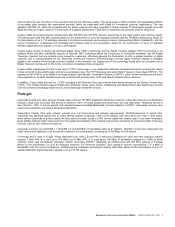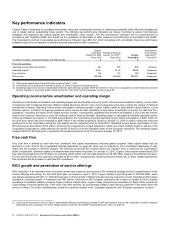Cogeco 2010 Annual Report Download - page 20
Download and view the complete annual report
Please find page 20 of the 2010 Cogeco annual report below. You can navigate through the pages in the report by either clicking on the pages listed below, or by using the keyword search tool below to find specific information within the annual report.Management’s Discussion and Analysis (MD&A) COGECO CABLE INC. 2010 19
Corporation’s Television services in the future. Alternative voice and data communications services are proliferating over the Internet, resulting
in the risk that fragmentation and disintermediation may also occur in the future with respect to the Corporation’s Telephony service.
Electronic communications increasingly rely on advanced security technology, terminal devices, control systems and software to ensure
conditional access, appropriate billing and service integrity. Security and business systems technology is provided worldwide by a small pool of
global suppliers on a proprietary basis. As other providers of electronic communications, the Corporation depends on the effectiveness of such
technology for many of its services and the ability of technological solutions providers to offer cost-effective and timely solutions to deal with
security breaches or new developments required in the marketplace.
Regulatory risks
In Canada, electronic communications facilities and services are subject to regulatory requirements depending mainly on the type of facilities
involved, the incumbent status of service providers and their relative market power, the technology used and whether the activities are
categorized as telecommunications or broadcasting. Canadian cable telecommunications facilities and services are subject to various
requirements, mainly under federal legislation governing broadcasting, radiocommunication, telecommunications, copyright and privacy, and
under provincial legislation governing consumer protection and access to certain municipal property and municipally-owned support structures.
Broadcasting licences and broadcasting certificates are still required for the operation of larger cable systems. Various licence and licence
exemption conditions apply in Canada. Canadian cable operators are also subject to Canadian ownership and control requirements. Changes
in the regulatory framework or licences, which are subject to periodic renewal, may affect the Corporation’s existing business activities or future
prospects.
The government of Canada issued a consultation paper in June 2010 on options for reform of Canadian ownership and control requirements for
the telecommunications industry in Canada. The three options under consideration are an increase of the direct limit on foreign ownership to
49%, removal of the limit for start-up telecommunications companies and telecommunications companies with less than 10% of total
telecommunications market revenues, and complete removal of the limit. The deadline for the filing of submissions was July 30, 2010. The
government has not reacted to submissions filed and has not indicated how it intends to follow up on the consultation process.
In addition to the support structures of power utilities, Cogeco Cable makes extensive use for its wireline network of the support structures of
Bell and Telus in its service footprint under terms and conditions set in tariffs approved by the Canadian Radio-television and
Telecommunications Commission (“CRTC”). Pursuant to Telecom Notice of Consultation CRTC 2009-432, The CRTC is currently considering
whether the support structure service rates of incumbent local exchange carriers (“ILECs”) such as Bell and Telus should be reviewed.
Contrary to the ILECs, cable carriers have argued that the pricing methodology used to determine current rates in effect is adequate and that
support structure service rates should not be increased. The CRTC is expected to issue a decision before the end of the calendar year.
In Telecom Notice of Consultation CRTC 2010-43, the CRTC initiated a proceeding to review access to basic telecommunications services and
other related issues, which include the obligation to serve, the local service subsidy, the existence and scope of the basic cable service
objective, local competition and wireless number portability in the service areas of small ILECs, and forbearance from regulation of mobile
wireless data services. A key issue under consideration is whether HSI access should be included in the basic service objective, and whether
the existing contribution regime for the support of local telephone service should be extended to HSI access services in high-cost service areas.
Public hearings will take place in October and November 2010, with a decision expected in the spring of 2011.
In Broadcasting Regulatory Policy CRTC 2010-167, the CRTC proposed to establish a value-for-signal (“VFS”) regime providing the right for
Canadian private local television stations to opt for either continued regulatory protection for the carriage of their signal and simultaneous
program substitution by Broadcasting Distrubution Undertakings (“BDUs”), or the negotiation of compensation for the value of the distribution of
their service by BDUs with the possibility to require deletion on all other distributed signals of all programs for which they have respectively
acquired exclusive contractual exhibition rights. Concurrently with this policy announcement, the CRTC issued Broadcasting Order
CRTC 2010-168 referring a question to the Federal Court of Appeal on the CRTC’s authority under the Broadcasting Act to establish the
proposed VFS regime. The reference was considered by the Federal Court of Appeal at a hearing in September 2010, and a decision is
expected by the end of the calendar year.
In another reference initiated by the CRTC, the Federal Court of Appeal ruled earlier this year that the CRTC does not have the statutory
authority to regulate the transmission of program content by Internet service providers (ISPs). Four cultural groups are currently seeking leave
to appeal to the Supreme Court of Canada.
In Portugal, Cabovisão has prevailed in its complaint to Autoridade da Concorrência (“AdC”) against the anticompetitive practices of PT
concerning access to support structures and ducts of the incumbent telephone company. AdC has imposed a fine of €38 million to PT, but the
AdC decision has since been challenged in court and the matter is still pending. Following complaints by other parties, AdC imposed a further
record-breaking €45 million fine to PT as well as an €8 million fine to its former subsidiary Zon for abuse of dominance and margin squeezing of
competitors in the broadband Internet access market in Portugal. PT and Zon have both decided to challenge this AdC decision in court and
the matter is still pending. Cabovisão has filed with AdC complaints against Zon that raise further issues of abuse of dominant position by that
incumbent cable, satellite and content service provider. In the absence of any significant remaining ex ante regulation of Portuguese
incumbents by Autoridade Nacional das Communicações (“Anacom”), the effective enforcement of the decisions issued by AdC, the
Portuguese competition watchdog, is essential to discipline the dominant Portuguese incumbents. Cabovisão has also filed with the
Competition Directorate of the European Commission a complaint concerning the fact that the dominant Portuguese incumbents have been
given access to funding from the European Investment Bank for debt-financing at favourable terms with the backing of the Portuguese
government, with the stated objective of helping these dominant Portuguese incumbents to further deploy fibre optic next generation networks
(“NGN”) in Portugal. The matter is still pending.
























